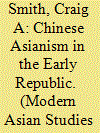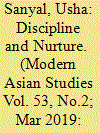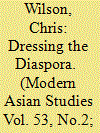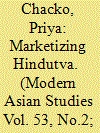|
|
|
Sort Order |
|
|
|
Items / Page
|
|
|
|
|
|
|
| Srl | Item |
| 1 |
ID:
164886


|
|
|
|
|
| Summary/Abstract |
Until recent decades, historians of modern East Asia generally considered Asianism to be an imperialistic ideology of militant Japan. Although Japanese expansionists certainly used the term and its concept in this way in the 1930s and 1940s, earlier proponents of Asianism looked upon it as a very real strategy of uniting Asian nations to defend against Western imperialism. Showing that Chinese intellectuals considered different forms of Asianism as viable alternatives in the early days of the Republic of China, this article examines a number of discussions of Asianism immediately following the 1911 Revolution. Concentrating on newspaper articles and speeches by intellectuals Ye Chucang and Sun Yat-sen, I show the international aspirations of the Guomindang elite at this crucial point in the construction of the Chinese nation. Despite the dominance of discourse on the nation state, these intellectuals advocated different Asianist programmes for strategic purposes within the first two years of the Republic, dependent on their very different relationships with Japan.
|
|
|
|
|
|
|
|
|
|
|
|
|
|
|
|
| 2 |
ID:
164891


|
|
|
|
|
| Summary/Abstract |
Most studies of Vietnam under the Diệm regime conceive it as a stepping stone of American nation-building efforts, citing Diệm's political approach as being influenced by modern, Western, and specifically American democratic concepts and by his associations with American advisers. Such studies assumed that the regime existed within this bubble, isolated from the past and from the society that it aimed to rule and shape. By contrast, this study contends that the regime was more deeply rooted in the enduring Vietnamese pre- and colonial history and in the post-1954 socio-political milieus, the defining components of which were intrinsically woven into the fabric of the Ngô nation. In its early years, the Republic of Vietnam (1955–63), led by the Ngô family and supporters, attempted to define itself as a nation incontestably heir to its pre-colonial past, while being increasingly conditioned by anti-communist and pro-Catholic patrimonialism. The 1956 commemoration of its 26 October National Day, the focus of the present analysis, provides insights into the values that essentially defined the Ngô’s nation—an entity far different from what its American godfathers had envisioned.
|
|
|
|
|
|
|
|
|
|
|
|
|
|
|
|
| 3 |
ID:
164881


|
|
|
|
|
| Summary/Abstract |
This article presents an ethnography of a contemporary residential madrasa for teenage Muslim girls in a North Indian town undertaken by a team of two researchers. We focused on different aspects of the overall study, with Sanyal conducting participant observation within the madrasa and Farah interviewing a select number of graduates and former students in their home environments. The result is a comprehensive picture of the madrasa's transformative role in the socio-religious lives of its students, which highlights the importance of the connections between the madrasa and the home.
Of significance are the religious and denominational orientation of the madrasa—Barelwi Sunni Muslim—as well as the working-class status of the girls and their parents’ low level of education. With limited resources, the madrasa inculcates in the students, and by extension their neighbourhoods and wider communities, a new awareness of religious duties and mutual obligations, and gives its students confidence and a voice within both their families and communities. The long-term potential impact of madrasas such as this one appears to be significant in contemporary North India.
|
|
|
|
|
|
|
|
|
|
|
|
|
|
|
|
| 4 |
ID:
164889


|
|
|
|
|
| Summary/Abstract |
This article analyses the dress practices of East African Indians from the late nineteenth century to the middle of the twentieth century, which have failed to attract much scholarly attention. It begins by examining the ways in which very material interactions with items of clothing, while separated from the body, were productive of identities and communities among Indian tailors, shoemakers, Dhobis, and others in East Africa. It then turns away from a specific focus on questions of identity to consider the ways in which dress was incorporated into the diasporic strategies of East African Indians as they sought to negotiate the Indian Ocean world. Finally, it explores how, where, and when Indians adopted particular dress practices in East Africa itself, to illuminate the role of dress in orderings of space, colonial society, and gender. The analytic value of dress, this article contends, lies in its universality, which allows for the recovery of the everyday lives and efforts of ordinary East African Indians, as well as a new perspective on elite diasporic lives.
|
|
|
|
|
|
|
|
|
|
|
|
|
|
|
|
| 5 |
ID:
164884


|
|
|
|
|
| Summary/Abstract |
Focusing particularly on the Madras College of Physical Education opened in 1919, this article reconstructs the role of the United States of America-dominated Indian Young Men's Christian Association (YMCA) in the spread of physical-education schemes in South Asia between the beginning of the century and the outbreak of the Second World War. American YMCA secretaries stressed the scientific, liberal, and egalitarian character of their ‘physical programme’ aiming at the training of responsible and self-controlled citizens and therefore supposedly offering an alternative to British imperial sports. The study demonstrates that the Y indeed exercised a considerable influence by acting as adviser to provincial and ‘princely’ governments as well as through the graduates of the Madras College of Physical Education (MCPE), many of whom became physical directors in educational institutions in India, Burma, Ceylon and other Asian countries. At the same time, it also makes clear that North American models could not be transplanted in a simple or straightforward manner to South Asian contexts. For one, in spite of its representation as a ‘school for democracy’, the Y's supposedly inclusive and emancipatory discourses and practices of physical fitness remained over-determined by the powerful influences of the colonial discourse of race, and the programme of the Indian Y continued to be rife with the imperial tropes of somatic Orientalism predicated on the idea of fundamental difference between Westerners and South Asians. Likewise, the Y's sports mission turned out to be less American than its advocates had hoped: ‘sportified’ versions of local games and physical exercises played an ever-increasing role in the numerous institutions of the Y in South Asia, leading eventually to a thorough ‘pidginization’ of its fitness regime.
|
|
|
|
|
|
|
|
|
|
|
|
|
|
|
|
| 6 |
ID:
164883


|
|
|
|
|
| Summary/Abstract |
Focusing on Chinese elite women who gravitated towards national affairs in the pre-war urban sites of eastern China and who migrated to Wuhan after the outbreak of the War of Resistance (1937–1945), this article analyses the emergence, development, and integration of their sociopolitical networks for the purpose of promoting women's participation in national salvation, against a backdrop of the deepening national crisis in the 1930s. I argue that two years before the Second Kuomintang-Chinese Communist Party (KMT-CCP) United Front was officially formed, these elite women, hailing from diverse social and political backgrounds and different professions, had already established their own leadership during the national salvation movement and called for a women's united front. Therefore, rather than being simply political rhetoric enhanced under the auspices of the KMT-CCP alliance, the women's united front served as an important institution with which Chinese elite women identified and through which they empowered themselves at a local and then national level, across and beyond geopolitical boundaries. I conclude that the birth and evolution of this women's united front, which have been neglected in the historiography of China's War of Resistance, are crucial to an understanding of unsettling negotiations, communication, and cooperation between the various forces signed up to the cause of national salvation in the 1930s, and to the interpretation of popular resistance before the war.
|
|
|
|
|
|
|
|
|
|
|
|
|
|
|
|
| 7 |
ID:
164890


|
|
|
|
|
| Summary/Abstract |
The ability to handwrite Chinese characters in East Asia appears to be in sharp decline, most likely due to an increasing reliance upon digital technology and phonetic input systems. This so-called ‘character amnesia’ has provoked a heated debate, leading some to argue that Chinese characters—and even the Chinese and Japanese languages and cultures themselves—are facing a serious crisis. This article aims to examine the scope of this (predominantly alarmist) discourse and assess the coherence and validity of its arguments. In addition, it seeks to make sense of the possible forces and motives behind this upsurge in ‘verbal hygiene’ by answering such questions as: what led to the formation of such a discourse in the first place? What social functions might it serve, and what kinds of deep-rooted beliefs and anxieties does such a discourse reveal?
|
|
|
|
|
|
|
|
|
|
|
|
|
|
|
|
| 8 |
ID:
164887


|
|
|
|
|
| Summary/Abstract |
The Khasi, Jaintia, and Garo Hills in the North East Frontier of British India were subject to shifting and differentiated forms of colonial governance. Defying notions of coexistence with or autonomy from colonial rule, the colonial history of this region was bound up with specific spatio-temporal constructions. By examining the nature of jurisdictional and political encounters in the Khasi, Jaintia, and Garo Hills, this article addresses the interruptions to imperial sovereignty in the Frontier. Imperial sovereignty moved in juridical forms, affecting and being affected by classificatory challenges such as hills and plains, hill tribal, and settler. The relationship between jurisdictional boundaries, plural authority, and imperial sovereignty appears in judicial and revenue files of different levels of the English East India Company government and the British government. Recurrent boundary disputes between the spatio-temporal units of hills and plains during the late eighteenth and late nineteenth centuries point towards contingent strategies of governance. The unfolding of these disputes over the course of the nineteenth century also show that law and jurisdiction as carriers of imperial sovereignty were spatially and temporally uneven. The historical processes highlighted in this article concern the sub-region of Khasi, Jaintia, and Garo Hills and parts of the Sylhet district of British Bengal, which, at present, constitute the Indian state of Meghalaya and parts of northern Bangladesh, respectively.
|
|
|
|
|
|
|
|
|
|
|
|
|
|
|
|
| 9 |
ID:
164880


|
|
|
|
|
| Summary/Abstract |
The embrace of markets and globalization by radical political parties is often taken as reflecting and facilitating the moderation of their ideologies. This article considers the case of Hindu nationalism, or Hindutva, in India. It is argued that, rather than resulting in the moderation of Hindu nationalism, mainstream economic ideas are adopted and adapted by its proponents to further the Hindutva project. Hence, until the 1990s, the Hindu nationalist political party, the Bharatiya Janata Party (BJP), its earlier incarnation, the Jana Sangh, and the grass-roots organization, the Rashtriya Swayamsevak Sangh (RSS), adopted and adapted mainstream ideas by emphasizing the state as the protector of (Hindu) society against markets and as a tool of societal transformation for its Hindu nationalist support base. Since the 1990s, Indian bureaucratic and political elites, including in the BJP, have adopted a view of the market as the main driver of societal transformations. Under the leadership of Narendra Modi, in particular, the BJP has sought to consolidate a broader support base and stimulate economic growth and job creation by bolstering the corporate sector and recreating the middle and ‘neo-middle’ classes as ‘virtuous market citizens’ who view themselves as entrepreneurs and consumers but whose behaviour is regulated by the framework of Hindu nationalism. These policies, however, remain contested within the Hindu nationalist movement and in Indian society generally. The BJP's discourse against ‘anti-nationals’ and the use of legal sanctions against dissent is an attempt to curb these challenges.
|
|
|
|
|
|
|
|
|
|
|
|
|
|
|
|
| 10 |
ID:
164879


|
|
|
|
|
| Summary/Abstract |
Japanese imperialism was one of the most important driving forces in the history of modern East Asia. One influential group of actors at the grassroots level were the so-called ‘continental adventurers’ (tairiku rōnin)—Japanese nationals who travelled in Korea and China on the lookout for adventures and employment opportunities. Some of them worked part time for the army as spies, translators, and agents for special operations. These adventurers have been studied before as agents of Japanese imperialism, but existing accounts fail to present a convincing model of the mechanism that made their activities effective. The goal of this article is to fill this gap.
This mechanism, which I shall hereafter call ‘the military-adventurous complex’, was a lobby of officers, continental adventurers, businessmen, politicians, criminal elements as well as Chinese, Manchurian, and Mongolian revolutionaries. The interests of these contingents were unique but nevertheless intertwining. Despite its decentralized character, the military-adventurous complex had a significant impact on Japanese foreign policy over an extended period. In this article, we shall explore the contours, structure, and modus operandi of that complex, its ambivalent relationship with the Japanese state, as well as several examples of its operations in the early twentieth century. Finally, we shall dwell on the ramifications of the complex on the development of Japanese imperialism.
|
|
|
|
|
|
|
|
|
|
|
|
|
|
|
|
| 11 |
ID:
164888


|
|
|
|
|
| Summary/Abstract |
Research on opium in colonial India has so far mainly focused on the competing Malwa and Bengal opium currents under the control of the Sindia and Holkar families and of the British East India Company, respectively. The historical trajectory has tended to emphasize the implementation of a draconian and all-encompassing British monopoly. This study joins the emerging efforts to search the regional histories on the margins of the strongest players’ actions on the global scene. It aims at nuancing the narratives by focusing on a region away from such centres. The study investigates the local cultivation and usage of opium in Rangpore district—a region in north Bengal that had recently been badly affected by a severe flood. Here, the drug was extensively used and the lucrative trade with neighbouring states gave small-scale cultivators an income also under hard environmental conditions. The fact that production and trade were small-scale, fragmented, and made use of markets in Cooch Bihar, Assam, and Bhutan impeded British attempts at getting in control of production and trade.
|
|
|
|
|
|
|
|
|
|
|
|
|
|
|
|
| 12 |
ID:
164885


|
|
|
|
|
| Summary/Abstract |
During their occupation of the Philippines from 1942 to 1945, the Japanese invaders aimed at making the archipelago become part of the so-called Greater East Asia Co- Prosperity Sphere (GEACPS, Daitōa kyōeiken)—a self-sustaining economic bloc that should act as a bulwark against Western imperialism. The underlying philosophy of the GEACPS was pan-Asianism (Han Ajia-shugi)—an ideology that propagated the liberation and unity of all Asian peoples. In the Philippines, the Japanese administrators faced various problems with the implementation of this ideology. The strong impact of four centuries under Western colonial rule had created a mindset among many Filipinos that they themselves were Westerners and not Asians. Therefore, one of the main purposes of the new Japanese rulers was to change the attitude of the Philippine population and win the Filipinos over to the concept of the GEACPS. One means to this end was the dissolution of all political parties in the Philippines and replacing them with the Kapisanan sa Paglilingkod sa Bagong Pilipinas (KALIBAPI: lit., ‘Association for Service to the New Philippines’). The Japanese wanted to turn this association into a mass organization with the ultimate goal to create a mass movement towards the establishment of the ‘New Philippines’ among the population. In this article, I will discuss how the Japanese administrators used the KALIBAPI to adopt their pan-Asianism to Philippine circumstances, but also how the organization exemplifies the ultimate failure of Japanese pan-Asianism in the Philippines.
|
|
|
|
|
|
|
|
|
|
|
|
|
|
|
|
| 13 |
ID:
164882


|
|
|
|
|
| Summary/Abstract |
This article explores the background to and consequences of the resignation of B. R. Sreenivasan as the vice-chancellor of the University of Singapore in October 1963, after a public clash with the People's Action Party state government, led by Prime Minister Lee Kuan Yew. Sreenivasan's resignation has been the subject of radically different historical interpretations. It has been celebrated by some nationalist historians as part of a process of cultural decolonization, but criticized by others as precipitating a two-decades long erosion of academic freedom in Singapore. Careful attention to the event and its context, however, offers a powerful heuristic concerning the place of higher education in the process of decolonization, and the manner in which colonial universities came to be symbolic repositories of nationalism that enjoyed some degree of autonomy from the state. Debates on the role of the university that arose in Singapore after the resignation were plural, and diverse, and have much to teach us not only about the past, but also about a future in which international research universities such as the National University of Singapore embrace contradictory roles and yet still strive for new forms of academic autonomy.
|
|
|
|
|
|
|
|
|
|
|
|
|
|
|
|
| 14 |
ID:
164878


|
|
|
|
|
| Summary/Abstract |
The consolidation of numerous regional polities in the aftermath of Mughal imperial decline presented favourable socioeconomic opportunities for South Asian service communities. Protracted armed conflicts in southern India allowed a variety of mercenaries, soldiers, and war bands to accumulate resources in exchange for mobilizing manpower on behalf of states with weak standing armies. This article focuses on British imperial efforts to obtain sufficient quantities of military labour during its struggle with the Mysore sultanate. As the sultanate assumed an increasingly hostile attitude towards independent warrior power, local strongmen sought more amenable arrangements with alternate entities. The British East India Company received crucial support from autonomous warrior groups during its southern wars of conquest. Warriors in turn utilized British resources to consolidate local sovereignties. Thus, the initial British intrusion into peninsular Indian society further fragmented the political landscape by patronizing petty military entrepreneurs.
|
|
|
|
|
|
|
|
|
|
|
|
|
|
|
|
|
|
|
|
|